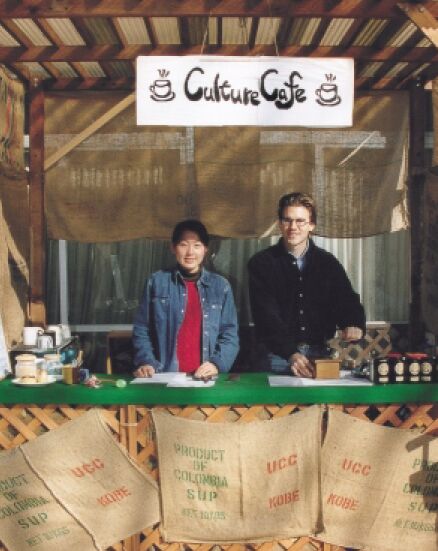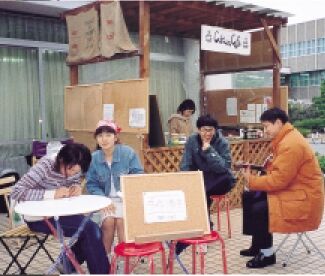Culture Cafe
Finding Friends at the Culture Cafe


For foreign students in Japan, meeting
Japanese students can be surprisingly
difficult. I have experienced this
difficulty first-hand while attending
Kyushu University. As an exchange student
following the typical pattern of most
foreign students in Japan, I too lived in
the dormitory for international students
and took the usual language and culture
classes. However, unlike most students
who return home after a year or two of
study, I chose to stay and enter the
Masterfs Program in Human-
Environment Studies. It was from this
time that I decided to apply what I had
learned in environmental psychology
toward solving a problem I sensed as
both strange and very unfortunate: international
students at Kyushu University
had stopped looking for Japanese
friends.
The Kyushu University International
House was where I first gave up looking
for Japanese friends. I lived there during
my first year in Fukuoka, and yes, I
did manage to make a number of new
friends from my tiny, one-person room
on the first floor of the (then) all-male,
five-story gBuilding E.h There were the
other American students, all strangely
bunched on the upper floors of the same
building. Most of them were here for just
one year, for a year of study abroad.
Then there were my Korean, Chinese,
and Brazilian friends, just to mention the
nationalities that stand out most in my
mind. They were scattered throughout
the many buildings of the International
House, and though it was often difficult
to keep track of where everybody lived,
we always managed to keep tabs on
each other in our new, closed-knit community.
There were, however, a couple of
Japanese students living in the
International House as resident assistants,
but they were graduate students
with many time restraints, and we
learned not to expect them to attend all
the parties and other social gatherings
we had. As for the many undergraduate
students of Kyushu University who may
have wanted to come to the International
House to make new friends or join a
party, most either didnft have a car or
couldnft afford to visit on a regular basis.
And though I had found a few friends in
my research group with whom I could
talk, I nonetheless found myself speaking
Japanese most with the other foreign
students in the International House
rather than with Japanese students.
That year I sure learned a lot about the
Korean Peninsula and Nisei lifestyles in
Brazil, but I was still in the dark about
how our Japanese neighbors lived. No
people, no communication.
The second place I had to give up
looking for Japanese companions was at
the International Student Center (ISC),
which is the building where almost all
new foreign students take Japanese language
and culture classes. I was no
exception, taking kanji and grammar
classes my first year. Again I found
myself surrounded by my International
House neighbors. We even parked our
bicycles in the same place. Of course
there were some faces I didnft know, but
one characteristic had not changed:
there were no Japanese students here.
And they never came. I sometimes
would see some Japanese students
hanging around the first floor of the ISC,
but a little eavesdropping would quickly
reveal that they were there specifically to
hear a speech (there is a large auditorium
on the first floor) or to sit through an
orientation for their own future study
abroad adventures. This was merely a
transitory stay, a brief stopover during
their academic journeys, and thus we
never saw them again. Again, no people,
no communication.
In 1998, my first year of graduate studies
at Kyushu University, I was given the
opportunity to change this situation of
being alongside, but not with, Japanese
students. I got together with a group of
classmates from my department, and
armed with some funding from the
Kyushu University Venture Business
Laboratory, we brainstormed for ideas
on how we could make our campus
more enjoyable and conducive to communication
among students, especially
to communication between foreign students
and Japanese students.
 What we came up with was simple
yet creative, new yet familiar: a coffee
shop. We built an outdoor cafe directly
on campus that provided everyone the
opportunity to enjoy inexpensive coffee
or tea in an open atmosphere, free of
any departmental affiliation or label. We
named it the gCulture Cafe,h to express
its function as a coffee shop while
encouraging a wide-ranging mix of
social exchange among students from
various cultural backgrounds. In addition,
by having all cafe staff positions
filled by students, we ensured the cafe
would remain elocalf and not appear foreign.
These staff were mostly undergraduate
students from a number of
departments, including engineering,
education, and agriculture. Working
hours were flexible, and there was
almost always an interesting mix of foreign
and Japanese students working at
any given time. As for the customers,
not only a variety of students, but also
professors, librarians, cafeteria workers,
and even local citizens, who were not
directly associated with the university,
became our regular customers.
What we came up with was simple
yet creative, new yet familiar: a coffee
shop. We built an outdoor cafe directly
on campus that provided everyone the
opportunity to enjoy inexpensive coffee
or tea in an open atmosphere, free of
any departmental affiliation or label. We
named it the gCulture Cafe,h to express
its function as a coffee shop while
encouraging a wide-ranging mix of
social exchange among students from
various cultural backgrounds. In addition,
by having all cafe staff positions
filled by students, we ensured the cafe
would remain elocalf and not appear foreign.
These staff were mostly undergraduate
students from a number of
departments, including engineering,
education, and agriculture. Working
hours were flexible, and there was
almost always an interesting mix of foreign
and Japanese students working at
any given time. As for the customers,
not only a variety of students, but also
professors, librarians, cafeteria workers,
and even local citizens, who were not
directly associated with the university,
became our regular customers.
In this way, what began in 1998 as a
pipe dream for an adventurous group of
students had become a prominent campus
feature by the year 2000. Though
only a small-scale project, I believe the
Culture Cafe takes an important step
toward improving the communication
gap between Japanese students and
international students by providing a
pleasant place for snacks and social
interaction on campus. As William H.
Whyte notes in his book, The Social Life
of Small Urban Spaces, gFood attracts
people who attract more people.h I
believe it.
By Chad Walker,
1st Year Ph.D. student, Human-
Environment Studies, Kyushu University
Previous
Page Top
Next


 What we came up with was simple
yet creative, new yet familiar: a coffee
shop. We built an outdoor cafe directly
on campus that provided everyone the
opportunity to enjoy inexpensive coffee
or tea in an open atmosphere, free of
any departmental affiliation or label. We
named it the gCulture Cafe,h to express
its function as a coffee shop while
encouraging a wide-ranging mix of
social exchange among students from
various cultural backgrounds. In addition,
by having all cafe staff positions
filled by students, we ensured the cafe
would remain elocalf and not appear foreign.
These staff were mostly undergraduate
students from a number of
departments, including engineering,
education, and agriculture. Working
hours were flexible, and there was
almost always an interesting mix of foreign
and Japanese students working at
any given time. As for the customers,
not only a variety of students, but also
professors, librarians, cafeteria workers,
and even local citizens, who were not
directly associated with the university,
became our regular customers.
What we came up with was simple
yet creative, new yet familiar: a coffee
shop. We built an outdoor cafe directly
on campus that provided everyone the
opportunity to enjoy inexpensive coffee
or tea in an open atmosphere, free of
any departmental affiliation or label. We
named it the gCulture Cafe,h to express
its function as a coffee shop while
encouraging a wide-ranging mix of
social exchange among students from
various cultural backgrounds. In addition,
by having all cafe staff positions
filled by students, we ensured the cafe
would remain elocalf and not appear foreign.
These staff were mostly undergraduate
students from a number of
departments, including engineering,
education, and agriculture. Working
hours were flexible, and there was
almost always an interesting mix of foreign
and Japanese students working at
any given time. As for the customers,
not only a variety of students, but also
professors, librarians, cafeteria workers,
and even local citizens, who were not
directly associated with the university,
became our regular customers.